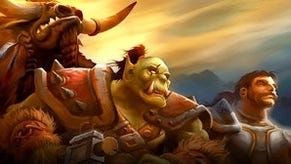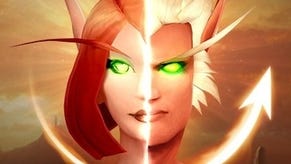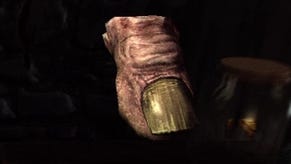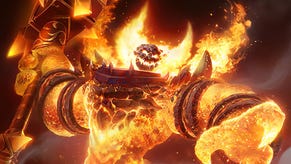World of Warcraft: The Burning Crusade
Still burning, still crusading.
The Good Soldier
Let's be honest, though. The questing from level 60 to 70 is a side-show, and experienced players will burn through it in a fortnight. Their more casual guild-mates will take a month to stroll through Outland's vast, graphically stunning zones; but this is a game you're expected to play for months. For a year, in fact, paying a subscription for the privilege each month. You won't be completing quests for that time; the real meat of this game, the rich red flesh that keeps people hooked, lies elsewhere.
The key is the game's dungeons. Seven new dungeon complexes were added in the Burning Crusade (with two more to follow in a forthcoming patch), each sporting multiple different "wings" which are essentially dungeons in themselves. You'll hit the first of these dungeon complexes, Hellfire Citadel, within hours of entering Outland, and further dungeons will open up to you as you progress before a vast array of new instances is made available at level 70.
Blizzard is great at designing dungeons; that much has been clear for a long time, and there are few instances in World of Warcraft which don't make for enjoyable play experiences - if you can spare the time, and find a group large enough to do them. It's no surprise, then, that the Burning Crusade sports a selection of extraordinarily well designed and scripted encounters. That's almost a given. Several key changes to Blizzard's approach do stand out, however.
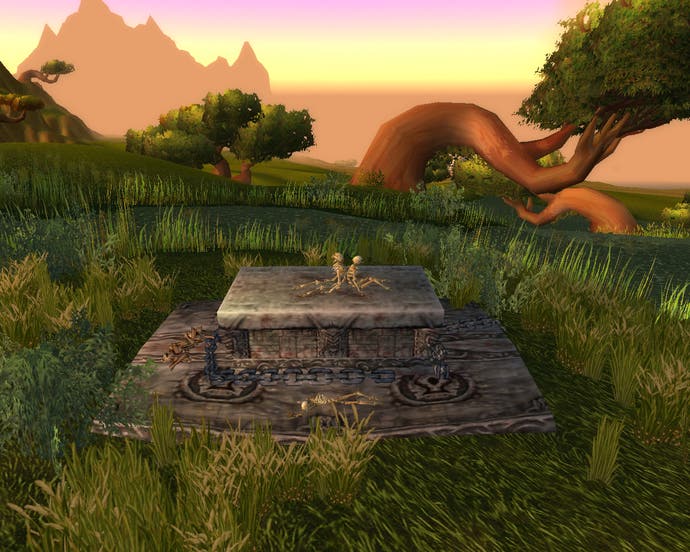
In essence, the changes are as follows: dungeons are shorter, they require fewer players, and you can play them either on Normal or Hard mode. These changes were controversial prior to the launch of The Burning Crusade, but the premature fury of the raiding hardcore now lies cold in its grave. Why? Because Blizzard was right all along.
Shorter dungeons don't mean less challenge, they means less filler. Smaller raid teams don't mean less strategy, they mean that it's even more vital that everyone in the team knows exactly what they're doing. Both factors combine to allow guilds to put together a couple of short raids a night, and give people who can't commit hours and hours on end to playing a videogame a chance to take part in the World of Warcraft endgame properly for the first time.
The upper limit on raid sizes has been dropped from 40 people to 25; still a daunting number of players to organise, but certainly a more reasonable goal for a large guild or a couple of medium-sized guilds working together. Most of The Burning Crusade's dungeons, however, feature wings designed for as few as five players, which makes it possible to complete them with just a few friends in tow. By far the most popular dungeons at present seem to be 10-man instances such as Kharazan, which offer a decent raiding challenge to the average guild, without being a logistical nightmare at the same time.
The Greater Good
In other words, The Burning Crusade has struck a balance in its endgame which World of Warcraft never quite found. The original game, for all its success, lost favour with many more casual players who found, after meandering their way to level 60 over the course of as much as six months, that there was nothing for them to do. Everything high-level required a large, active guild and the ability to commit entire evenings, several days a week.

The clever introduction of special Player vs Player battles solved the problem to some extent, but the Burning Crusade has eradicated it entirely. For perhaps the first time ever in an MMOG, the end-game experience is finally open to everyone. There will, inevitably, be complaints that it has been dumbed down, just as WoW has faced complaints in the past that it doesn't offer enough for high-level players; presumably the kind of high-level players who want their MMOGs to come packaged with special bottles for pissing in. So far, though, such complaints have been surprisingly muted. It looks like for now, at least, the balance works for everyone.
This isn't to say, of course, that The Burning Crusade gets everything right. The game is still, after all, a subscription MMOG, and its job is to keep players paying for the game month after month. What it can't do entirely through fun, it does instead by dangling a carrot in front of players anxious to progress and upgrade their characters. And for every evening you'll spend in a fun raid group, you'll spend two mindlessly grinding away at various types of creature. Some things never change.
Admittedly, the grind isn't for XP, which is something. Instead you'll find yourself grinding for gold. The highest level flying mounts, which really open up the game in a variety of ways (especially farming natural resources and PvP combat) cost an astonishing 5000 gold, and there are plenty of other sinks waiting to drain away your resources. You'll find yourself grinding for reputation with various factions. Without having high reputation (earned by completing quests at first, but ultimately only attainable by crawling through dungeons repeatedly) you'll be unable to access Heroic dungeons and a variety of rewards. You'll find yourself grinding for crafting materials, some of which have pathetic drop rates, because otherwise some of the game's best equipment will be denied to you.

This is a component of every MMOG. We mention it only because it's worth noting that whatever else may be fixed in the Burning Crusade, this is still a core element of the game. The pay-off is that raid groups are incredibly good fun (with the condition that if you play with morons, even the best game will be awful); but if having to spend time grinding for gold, reputation or items in between raids seems like the kind of thing that would turn you off going back into World of Warcraft, well, caveat emptor.
The Day The World Went Away
The other thing which Burning Crusade gets wrong, arguably, is that it breaks a lot of the high-level content which already existed in World of Warcraft. This was inevitable, but it's still potentially frustrating. Former top-end zones like the Eastern Plaguelands and Silithus are all but abandoned, getting a raid together for the old dungeons is practically impossible, and even the PvP environments - which were a hive of activity prior to the launch of TBC - are now largely devoid of life. PvP, admittedly, has been superseded to some extent by Arena combat, which sees teams of 2, 3 or 5 facing off with one another, but this aspect of the game is in its infancy and we actually found it quite tough to actually get a decent number of matches. It's promising, though, and it will be interesting to see how it develops.
The old capital cities, at least, remain full - not just of low-level adventurers, but also of high-level characters who must return there to use facilities like the Auction House. However, the experience of approaching level 60 must now be a very strange one for new WoW players. Entire trails of quests lead into dungeons where nobody goes any more, and at level 58, you just down tools on all the quest chains you were doing and head to Outland instead. It's an abrupt leap, and it makes Blizzard's hard work on the previous content completely pointless, although we fully expect that rebalanced "Heroic" versions of those dungeons will appear at some point in the future.

Regardless of these complaints, The Burning Crusade has turned out to be a resounding success to an extent which few had expected. Three months into the lifespan of the expansion pack, it's clear that new life has been breathed into a game which was threatening to grow stale for many players. Superb graphics, sound and playability are simply to be expected from Blizzard at this point in time, and it's worth noting that if your machine was being pushed to its limits by WoW, you'll be turning down a few more graphical settings when you get to Outland. However, Blizzard's achievement here is far, far more than simply to offer a pretty, nice-sounding and eminently playable "more of the same" to its players.
In a genuinely striking move, The Burning Crusade simultaneously gives World of Warcraft veterans the swathes of new content they've been crying out for, and makes the end-game experience vastly more open to casual players or new players. Rather than merely catering to its hardcore audience, Blizzard has actually extended the accessibility of WoW to bring even more people into the fold.
There's never been a better time to get into WoW, or to reactivate your account if you're a lapsed adventurer; but be warned. Like the Hotel California, you can check out any time you like; but you can never leave.
Pop over to Eurogamers and see what's happening in the World of Warcraft group.

